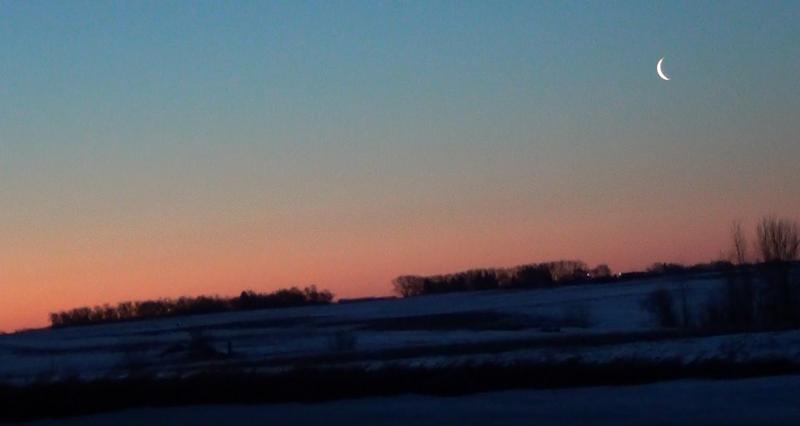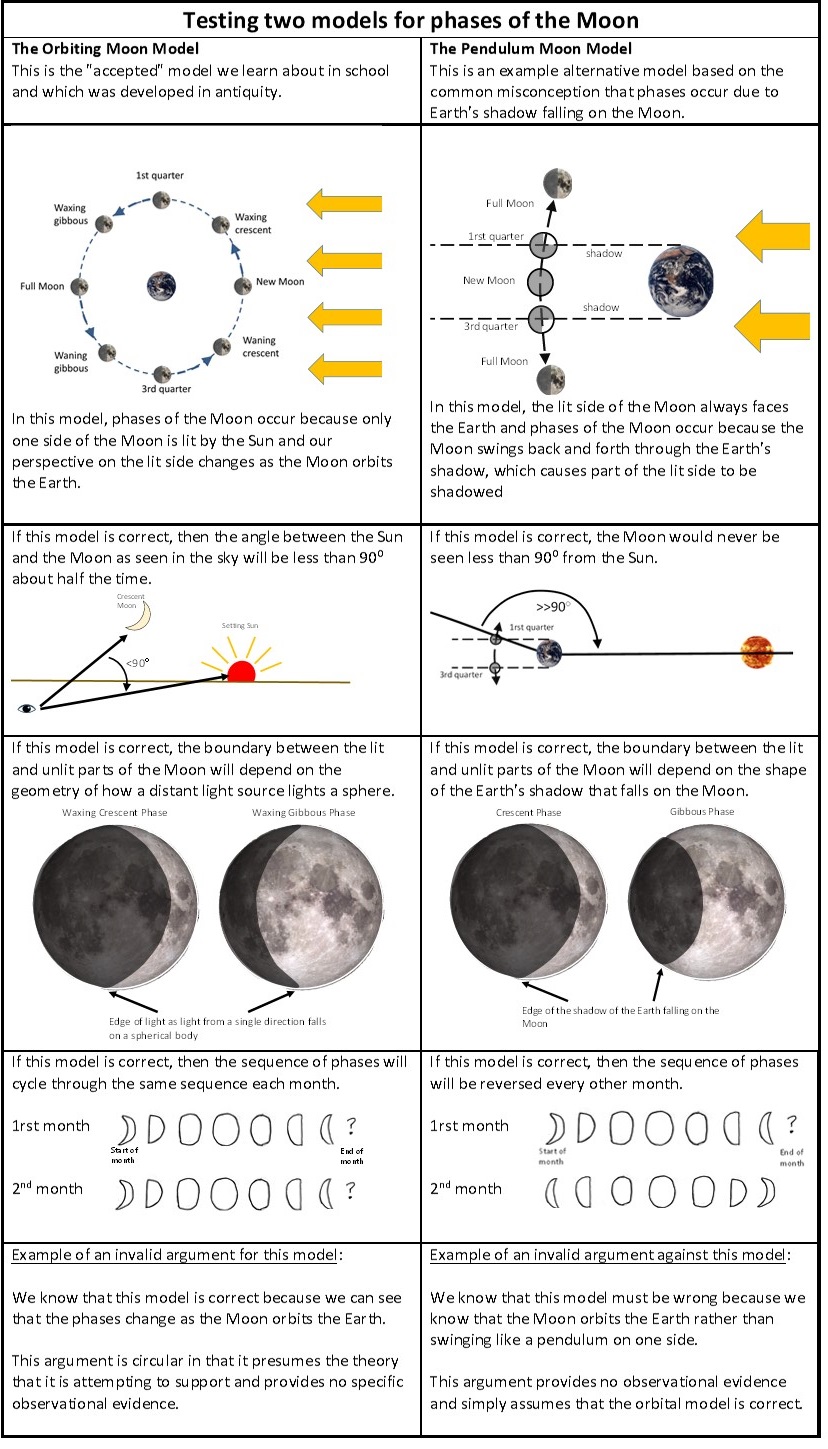
Earth Science Extras
by Russ Colson

Crescent Moon at sunrise near the Northern Hemisphere spring equinox in NW Minnesota.
As with the pattern of seasons and positions of the stars and sun, people have noticed the predictable pattern of phases of the Moon for thousands of years. The pattern involves predictable repetition of the phases of the Moon with time and the observation that the location of the Moon in the sky, the time of day, and the phase of the Moon are predictably correlated to each other. From the observaton of these predictable patterns people constructed the model for what causes the phases of the Moon that we examined in the lecture, From this model, we can make predictions about the nature of the Moon and it's relationship to the Earth. Using your notes from the lecture, and your understanding of the model for the phases of the Moon, answer the following questions that were asked in the lecture.
The model for the phases of the Moon has been illustrated in many ways, including the models drawin in lecture and that drawn below (from Colson R and Colson M (2018) Investigative Classroom Science: A Cure for National Skepticism of Science? in In the Trenches, v8 National association of geoscience teachers)

Sometimes students imagine that the picture itself is the model, rather than an illustration of the model that you build inside your head. Memorizing a picture is not at all the same things as understanding a model. For example, the 'inside-your-head" model still works if the Earth orbits to the other side of the sun (combining the Moon phase model with out model for seasons), whereas the memorized picture might not. The 'inside-your-head" model still works if we consider what the phase would look like if viewed from above the South Pole (rather than the North Pole). To get yourself ready for some questions about the "insdie-your-head" model, you might think about the picture above and what it means in the real world. You might also visualize the model in motion, with the Moon orbiting the Earth and the Earth orbiting the sun. There are animations of the model that you can look at to help with your visualization. Go online and search for "moon phase model animations" to watch some of these animated models. After watching these animations, and thinking more about the Moon phase model, answer the questions below.
All picture models have elements of reality that they portray accurately, but other aspects of reality that they don't portray well. When we modeled seasons, the scale of the model was not accurate. This is also true for phases of the Moon. If we were to show the Earth, Moon, and sun to scale, and put it all on a single page, the Moon would be too small to see and the Earth would only be a tiny dot. But, some aspects of scale should be included in picture models for Moon phases.
A key idea of the Next Generation Science Standards (2013) is that it is at least as important to learn how to do science investigation as it is to learn the theories and models that we have learned through scientific investigation. Although the construction of the model for phases of the Moon is based on observations that anyone can make, and that people have made for thousands of years, often students are taught only to learn and apply the model, not how to develop the model or test the model based on observational data.
Rather than simply read this text and 'learn' about the model for phases of the Moon, take some time to make your own observations of the Moon and test two different models for the cause of Moon phases. Watch how the phases change over time. Watch where in the sky the Moon appears and and what time of day, and how that changes over the period of a month. Make at least one qualitative observation and one semi-quantitative measurement that tests the accepted model for phases of the Moon, and disproves an alternative model, like that proposed in the chart below.
The chart below portrays the accepted model for phases of the Moon, plus an alternative model based on a common misconception that phases of the Moon are caused by Earth's shadow falling on the Moon. The chart also shows some qualitative and quantitative observations that can test each of the models. Every scientific model makes predictions that can be tested against observation. Some example predictions and tests are provided in the chart below. The chart also provides some example invalid arguments that might be made for one model or the other. Consider these as you do your small investigation to test models for the phases of the Moon.

(This investigative testing of Moon phase models is modified from Colson R and Colson M (2018) Investigative Classroom Science: A Cure for National Skepticism of Science? in In the Trenches, v8 National Association of Geoscience Teachers)
The investigation above may take a few days to complete (since you will have to find the Moon and make observations). Feel free to continue with the science reasoning puzzles below before completing the investigation.
Students often struggle to tell the difference between observation and the model or theory that is based on that observation. This is due in part to the fact that students are often taught to understand and explain the theories but are not taught how to figure the theories out from observations made in the universe. Here are some science reasoning exercises on identifying evidence related to phases of the Moon.
As discussed in the lecture, we can use the "space alien" model of the Earth, Moon, and sun to predict the position of the Moon in the sky as a function of Moon phase and time of day. A diagram to help visualize that process is provided below. The diagram below and the following "Murder Mystery" puzzles come from the book Learning to Read the Earth and Sky, Colson and Colson, 2016 NSTA Press.

The illlustration above shows the time of day at different locations on the Earth (for example, midnight on the side of Earth away from the Sun and noon on the side of the Earth toward the Sun). Although there is no north, south, east, or west in this picture, there is an east and a west as viewed from the Earth's surface, and these directions are indicated by the arrows. As viewed from above the North Pole, Earth rotates counterclockwise, or toward the east. This model can aid in visualizing where in the sky the Moon will be during different phases and times of the day. For example, at midnight on the side of the Earth away from the Sun, the first quarter Moon will just be setting because it will appear on the western horizon as the Earth rotates toward the east. If the Moon were full at this same time of day, the full moon would appear overhead, half-way through its journey across the sky. A new moon would be on the other side of the Earth.
Consider the following "Murder Mystery" science reasoning challenges. The "Murderer" in each case is the suspect whom you catch telling a lie as they try to construct their alibi. You are able to catch them in the lies because of your understanding of the phases of the Moon.
last updated 4/11//2020. Text and pictures are the property of Russ Colson.